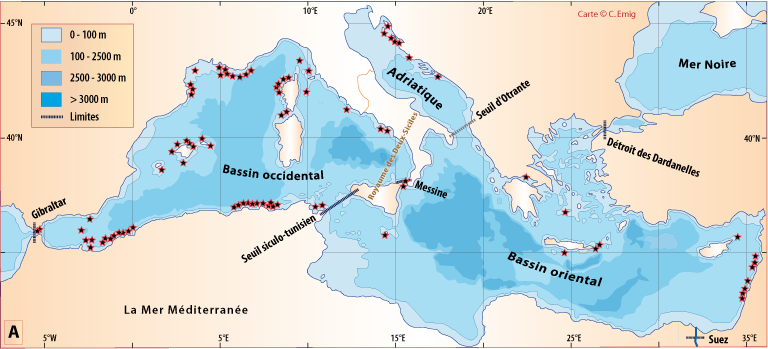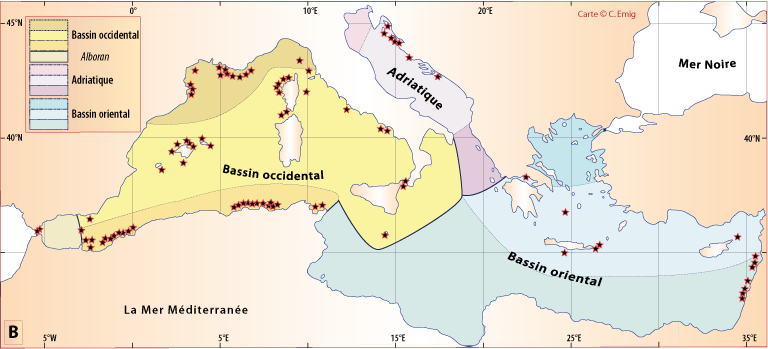

Figure 6 : Répartition de Novocrania en mer Méditerranée.- A. En fonction de la géographie et de la bathymétrie, avec les principales limites dans les échanges des masses d'eaux, qui ont évolué depuis le Miocène. B. en fonction des caractéristiques faunistiques (modifiée, d'après , 1970). La circulation des masses d'eau et les variations du niveau de la mer au cours des glaciations sont des facteurs primordiaux dans l'évolution des faunes méditerranéennes ( & , 2004).
Actuellement, ce genre ne comprend probablement qu'une seule espèce dans cette mer : N. anomala qui est citée
par la majorité des auteurs, quelques-uns citant N. turbinata, la plupart avec N. anomala. En outre, une référence à des animaux vivants ou à des coquille vides n'est pas toujours clairement indiquée ; dans le deuxième cas, l'âge des valves vides peut atteindre plusieurs centaines de milliers d'années.
Pour établir cette carte,
de nombreux travaux ont été compulsés
(suit une liste non exhaustive : , 1836 ; ,
1886 ;
, 1896 ;
, 1914 ;
, 1915 ; & ,
1941 ; ,
1962 ; ,
1964 ;
, 1967 ; , 1971 ;
& ,
1986 ; & ,
1987 ; , 1988 ; , 1989 ; et
al., 1991 ; ,
1994b ; & , 1995 ; , 1996b ; et al., 1999 ;
et al., 2000 ; , 2003, sous presse ; , 2003 ; & ,
2003 ;
et al., 2006 ; et al.,
2006 ;
et al., 2009 ;
et al., 2011 ;
et al., 2014 ; ...).
Figure 6: Distribution of Novocrania in the Mediterranean Sea.- A.
Controled by geography, bathymetry, and the main boundaries of water
mass exchange, which have evolved since the Miocene. B. According to faunal characteristics (modified from , 1970). The circulation of water masses and changes in sea level during glaciations are key factors in the evolution of the Mediterranean fauna ( & , 2004).
At present, probably only one species of this genus occurs in the Mediterranean Sea.
This is N. anomala, which has been identifed by almost all authors.
Some cite N. turbinata occurring with N. anomala.
Information on the shells, living or empty, is rarely indicated; the age of empty valves may reach several hundreds of thousands of
years.
Many
studies were looked through to build this map (a non-exhaustive list
follows: , 1836; ,
1886;
, 1896;
, 1914;
, 1915; & ,
1941; ,
1962; ,
1964;
, 1967; , 1971;
& ,
1986; & ,
1987; , 1988; , 1989; et
al., 1991; , 1994b; & , 1995; ,
1996b; et al., 1999;
et al., 2000; , 2003, in
press; , 2003; & ,
2003;
et al., 2006; et al.,
2006;
et al., 2009;
et al., 2011;
et al., 2014; ...